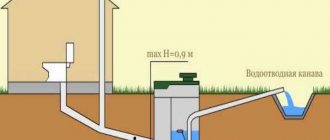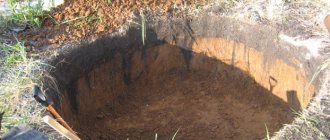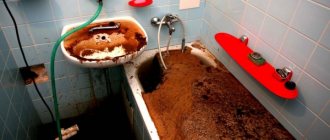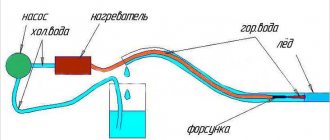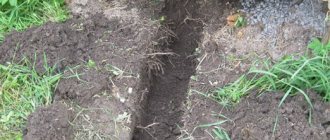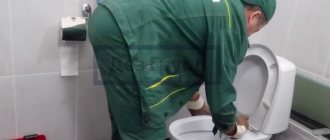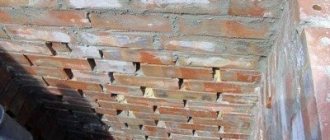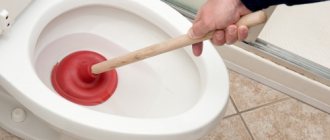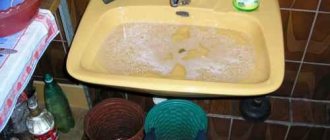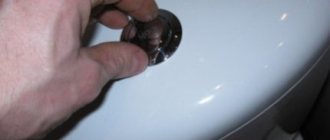Owners of private houses are especially concerned about the question “What to do if the cesspool quickly fills up and freezes in the winter?”
Why does a cesspool fill up quickly after pumping?
There is only one reason for this - the soil no longer absorbs water, which fills the sump tank or goes into the filtration field (if there is one). At the same time, the refusal of the soil to accept wastewater has several explanations, namely:
- Due to the insufficient activity of anaerobic bacteria, the bottom layer of a septic tank or pit is covered with silty sediment, which forms a buffer film that prevents contact between soil and water. As a result, your cesspool or septic tank quickly fills up, since the liquid does not go anywhere, but remains in the container.
Siltation of the bottom in the septic tank
- The walls and bottom of a septic tank or pit are covered with grease and soap deposits, the source of which is kitchen drains. If you don't have a grease trap, then you shouldn't even be surprised at how quickly your septic tank fills up. Fatty sediment clogs the drainage channels and blocks the flow of water through the bottom, overflows or through the side windows in the body of a homemade septic tank.
In some cases, poorly soluble grease and soapstone clog the entire inner surface of the sewer pipe, completely stopping the flow of waste to the septic tank or cesspool.
grease in the septic tank
- The sewer system simply cannot handle the waste . According to standards, the volume of a septic tank must be at least three days’ water consumption. Accordingly, an increase in the load on the water supply system (more residents spend more water) leads to the fact that the septic tank quickly fills up - the liquid simply does not have time to go into the ground
- The soil simply freezes , and frozen soil does not accept water under any circumstances. In addition, sometimes an ice plug appears in the septic tank or sewer pipe, blocking the movement of drains.
Now that the reasons for the failure of the sewer system have been established, we only need to understand what to do if the cesspool or septic tank fills up quickly. Therefore, next we will analyze the most effective ways to counteract specific causes of breakdown of a local or autonomous wastewater disposal system.
Chemicals against pit siltation
Chemicals can also be used to combat poor water outflow from a septic tank. Formaldehydes, nitrate oxidizers and ammonium compounds are used as the basis for such products. All of them quite effectively dissolve silt and fatty deposits on the walls of the septic tank. But there are a number of features regarding the use of chemicals for pit cleaning:
Construction of a cesspool for a private house
- Thus, formaldehyde agents kill soil for at least 7-10 years. That is, even a weed will not grow near the septic tank during this period. Therefore, formaldehyde preparations are used extremely rarely.
- Ammonium-based preparations only work at positive temperatures. But they effectively eliminate unpleasant odors from the septic tank pit, dissolve all silt and greasy deposits on the walls and bottom of the tank.
- The best option for chemicals when dealing with poor water outflow are products based on a nitrate oxidizer. Sludge dissolved using this product can be used to fertilize gardens and gardens.
Important: it is recommended to work with chemicals in a protective respirator and rubber gloves.
Restoring the absorption capacity of the soil
This method is only relevant for owners of cesspools and homemade septic tanks with an open bottom. In this case, to restore the absorbency of the soil, you will have to flush the sewer, and this is done like this:
- We call a vacuum cleaner and pump out the contents of the cesspool or septic tank.
- We fill the container, but not with fecal waste, but with clean water.
- We let the water sit for a day, during which we do not use chlorine-containing preparations (detergents and cleaners) under any pretext.
- We introduce a starting portion of anaerobic bacteria or biological products with an increased dose of such microorganisms into the septic tank or pit. If the drug manufacturer recommends this, we repeat the procedure for 5-7 days.
The meaning of these actions is to dilute the bottom silt with clean water and launch intense anaerobic and aerobic fermentation, which eats up even compacted sediment. There is no need to repeat pumping the septic tank after this procedure, but throughout the year you will have to use a fresh portion of bacteria every month to maintain fermentation.
We can recommend the following options as a starting drug:
Septic Shock Bioforce is a liter bottle containing powerful bacteria, surfactants and enzymes for immediate colony growth. To start, one bottle per 1000 liters of sump volume is poured into the container, so if your drainage pit or septic tank fills up quickly, buy several Septic Shock bottles at once. The issue price is 930 rubles per bottle.
Doctor Robik 509 is a liter container with very active cultures, which are designed specifically for shock cleaning of septic tanks and pits. The drug is introduced into the sump after the initial pumping, at the rate of one bottle per 2000 liters of sump volume. The price of impact cleaning is 630 rubles per bottle.
To maintain fermentation and purify the container, the following preparations should be used:
Dr. Robic 309 is a septic tank cleaner that works for a year. Available in liquid form, in liter bottles. One bottle is enough for 2000 liters of sump volume. Inserted through an inspection hole or central hatch. The cost of the bottle is 750-760 rubles.
Doctor Robik 409 is a cesspool product that supports the fermentation process throughout the year. The ideal time to apply the drug is spring or summer. The liter bottle Doctor Robik 409 is designed for 2000 liters. The cost of the product is 630 rubles per bottle.
How to deal with siltation
But if the cesspool is still filled. what to do? Methods for cleaning collectors may vary. But, most likely, the owners of a suburban area will need to carry out one of the following procedures:
- try to clean the hole manually;
- try to pump out the sludge with a fecal pump;
- use special biological products.
Sludge also accumulates at the bottom of the pit because sewage disposal equipment cannot pump it out. Therefore, its accumulation gradually occurs in the collector. To get rid of this sediment, among other things, you can simply pour water into the hole. As a result, the sludge will become much more liquid and the sewer truck will be able to pump it out. But this, of course, will make the pit cleaning procedure more expensive. It is quite possible that calling a special sludge pumping machine will cost a little less.
What to do if a septic tank with a closed bottom silts up?
The problem of increased concentration of sludge in the bottom part can also arise in factory septic tanks with a closed bottom. The reason for the appearance of deposits in this case is not the loss of soil throughput, but the low concentration of fermentation bacteria in the sump.
The cultures responsible for the breakdown of solid inclusions in drains are literally burned out by chlorine, alkali and acids included in preparations for cleaning dishes, surfaces, stoves, trays, bathtubs and toilets.
If your factory septic tank is full of sludge - the liquid in the gravity sump resembles sour cream in consistency - you need a loading dose of a biologically active drug, for example, the same Doctor Robik 509 or Septic Shock Bioforce
Remember that active biological products alone will not correct the situation - you will have to give up frequent use of household chemicals. Otherwise, your septic tank will become clogged with sludge again.
Elimination of unpleasant odor
The stench accompanies almost all street toilets and cesspools. If ventilation is connected, the unpleasant odor spreads less throughout the area, but does not disappear. To combat this nuisance, you must first clear the drain of sludge, which is the main cause of the stench, and then carry out preventive work.
- Good reviews about microbiological means for cleaning wastewater tanks. They not only effectively combat sludge and solid parts, but also completely eliminate odor. This option is not suitable for cleaning pits with soapy or chlorinated wastewater;
Microbiological odor control agent - Chemical cleaning agents are universal, they can eliminate odors in any conditions. But acids and alkaline compounds can damage the integrity of plastic and metal drums. Therefore, they are used exclusively in concrete drains.
Video on the topic:
Removing grease and soap residue
In factory septic tanks with a closed bottom, the main reason for the rapid filling of the sump tank is the formation of grease or soap deposits, which impedes the movement of liquid sediments through the overflow channels. However, soap and grease plugs can also form in homemade sewers. Moreover, the very fact of their occurrence is only a matter of time, if the sewer does not have a grease trap or a separate sump for kitchen waste.
To remove soap and grease plugs, you can use two methods - mechanical and chemical. Moreover, the second option works much more efficiently than the first and is implemented without any effort.
soapstone
To do this, you need to pour the required bactericidal preparation into the sinks, toilet and bathtub. And repeat this procedure until the sewerage capacity and overflows are restored.
In practice it looks like this:
- We pump out the septic tank. Fill it with water. Let the water sit so that the chlorine evaporates from the liquid.
- We pour preparations into sinks, bathtubs and toilets that can destroy soap and grease deposits.
- We begin to use the sewer system by monitoring the capacity of the pipes and the water level in the septic tank. If necessary, add an additional portion of the drug.
- After restoring the capacity of the overflow channels, we introduce supporting cultures that can absorb fat deposits.
The following options can be used as a preparation for removing soap and grease:
Roetech K-87 is an effective culture that can cope with cellulose (paper), soap plugs and grease film. One bottle is designed for 1000 liters of septic tank volume. The cost of one bottle is 800 rubles.
Drainage Comfort from BIOFORCE is a powerful preparation in sachets, dissolved in a 10-liter bucket. This dose is enough to clean a 50-meter section of a standard sewer pipe from grease and soap deposits. The Drainage Comfort package contains 10 sachets. Package price – 2770 rubles.
Dr. Robik 809 is a soapstone solvent that cleans overflows and the primary chamber of a septic tank. One bottle of Robik 809 frees the 2-cubic chamber of a septic tank from soapstone and sediment. The drug is injected into the toilet or poured into the viewing window. The cost of the bottle is 630 rubles
After cleaning, the administration of fat-removing drugs will have to be repeated annually, but without pumping out the septic tank.
What to do if wastewater freezes
Often a septic tank fills up too quickly simply because the liquid in it freezes. This problem usually arises when the technology for assembling the external part of the sewer system of the house is not followed. Pipes for water drainage should be laid below the freezing level of the soil at a slight angle. At the same time, it is advisable to additionally insulate them. The cesspool itself must also be covered with a lid with a layer of insulator.
But, of course, in winter it is unlikely that it will be possible to correct deficiencies in the installation of sewage systems when the drains freeze. This operation should be postponed until spring. The pipes and the pit themselves will have to be defrosted. The easiest way to do this is using electric current. In this case, work is done as follows:
- A copper rod rated at 2 kW is stuck into the ice formed in the cesspool.
- The end of the rod is connected to a wire powered from the phase.
Site owners who decide to defrost the pit in this way will have to be patient. The wastewater will melt for a day or two. Of course, such work should be performed in compliance with all necessary safety measures. You need to wear special boots on your feet, and dielectric gloves on your hands. After the pit has defrosted, the rod is first de-energized, and only then pulled out. Well, of course, this method should only be used by those people who have experience working with electricity.
We arrange the removal of clarified wastewater
If you have problems with a septic tank overflowing, which can no longer withstand the increased number of consumers, then you will have to either build a drainage well or equip a filtration field.
No drugs can solve the problem of insufficient septic tank capacity. If the daily water discharge exceeds 1/3 of the volume of the sump, then the construction of a well or filtration field is an almost inevitable step, the only alternative to which would be to dismantle the old septic tank and install a new treatment plant.
Drainage well
The basis of such a structure is a shallow shaft of 3-4 meters, dug to sandy soil layers. Usually it comes off at a distance of up to 5 meters from the septic tank and is connected to the sump tank by a separate pipeline with a diameter of 110-150 millimeters. The pipe must go at a slope (towards the well), with a height difference of 2 centimeters per linear meter of line.
The walls of the drainage well are reinforced with concrete rings, the bottom of which will have to be perforated by drilling many holes with a diameter of 15-20 millimeters in its body. Clarified water from the septic tank overflows into the well and goes into the sandy soil horizon.
An alternative option is a polymer drainage well, assembled by 2-3 people from plastic parts (bottom, ring with pipeline outlets, telescopic neck).
Filter field
This is a larger-scale system consisting of a perforated pipeline buried a meter into the ground. Moreover, the perforated pipes are laid on a sand and gravel bedding with a thickness of 25 centimeters and covered with the same mixture.
Arrangement of the filtration field involves digging a trench, placing bedding at its bottom and laying pipes. After assembling the pipeline, it is covered with a 20-centimeter layer of sand and gravel backfill. Finally, the trench is filled with selected soil.
The filtration field pipeline runs at a slope of 2.5 centimeters per linear meter, so the depth of the trench can vary from 1 to 1.5 meters. As a rule, at least 8 linear meters of the filtration field pipeline are allocated per user, so owners of large-volume septic tanks dig not one trench, but several, placing 5 or 10-meter sections parallel to each other.
